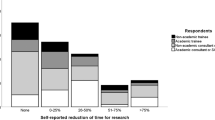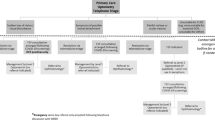Abstract
EEC staff were provided with rapidly changing personal PPE guidance by Public Health England (PHE) with specific subspecialty advice from the British Emergency Eye Care Society (BEECS) and the Royal College of Ophthalmologists (RCOphth) UK during the COVID19 pandemic. BEECS undertook a baseline survey of its members after the initial response from the RCOphth 16/3/20 mirroring Public Health England (PHE) advice and a follow- up survey after the guidance was updated on 9/4/20. A combined total of 84 responses were received. Improvements after RCOphth changes between the two surveys from hospital respondents showed increases in temperature screening (13%), scrub use (34%), use of aprons (31%), masks (4%), eye protection (35%), gloves (25%) and slit lamp guard (1%). Our findings demonstrate a positive and significant adaptation of PPE in response to change in guidance published by PHE, RCOphth and BEECS between 16/3/20 and 11/4/20. The COVID19 pandemic has rapidly taken over the normal activity of Ophthalmic departments creating unprecedented challenges. Following initial confusion and vulnerability expressed by EEC professionals to PPE guidance, most Trusts appear to have adapted and are doing similar things. The response has been swift and effective as a result of good team work and early advice from BEECS and the RCOphth. On the whole, management teams are listening.
Similar content being viewed by others
Log in or create a free account to read this content
Gain free access to this article, as well as selected content from this journal and more on nature.com
or
References
WHO. www.WHO.int. Accessed April 2020.
Royal College of Ophthalmologists. www.rcophth.ac.uk. Accessed March 2020.
www.college-optometrists.org. Accessed April 2020.
Wu Z, McGoogan JM. Characteristics of and important lessons from the coronavirus disease 2019 (COVID-19) Outbreak in China: Summary of a Report of 72 314 Cases From the Chinese Center for Disease Control and Prevention. JAMA 2020;323:1239–42.
Zhou Y, Zeng Y, Tong Y, Chen C. Ophthalmologic evidence against the interpersonal transmission of 2019 novel coronavirus through conjunctiva. medRixiv. 2020. https://www.medrxiv.org/content/10.1101/2020.02.11.20021956v1.
Wu P, Duan F, Luo C, et al. Characteristics of ocular findings of patients with coronavirus disease 2019 (COVID-19) in Hubei Province, China. JAMA Ophthalmol. 2020. https://doi.org/10.1001/jamaophthalmol.2020.1291.
Lu CW, Liu XF, Jia ZF. 2019-nCoV transmission through the ocular surface must not be ignored. Lancet. 2020. https://doi.org/10.1016/s0140-6736(20)30313-5.
Li JO, Lam DSC, Chen Y, et al. Novel Coronavirus Disease 2019 (COVID-19): the importance of recognising possible early ocular manifestation and using protective eyewear. Br J Ophthalmol. 2020;104:297–8.
Acknowledgements
We acknowledge BEECS committee members for this work.
Author information
Authors and Affiliations
Corresponding author
Ethics declarations
Conflict of interest
The authors declare that they have no conflict of interest.
Additional information
Publisher’s note Springer Nature remains neutral with regard to jurisdictional claims in published maps and institutional affiliations.
Rights and permissions
About this article
Cite this article
Shirodkar, Al., De Silva, I., Verma, S. et al. Personal Protective Equipment (PPE) use among emergency eye care professionals in the UK during the COVID19 pandemic. Eye 34, 1224–1228 (2020). https://doi.org/10.1038/s41433-020-0970-5
Received:
Revised:
Accepted:
Published:
Issue date:
DOI: https://doi.org/10.1038/s41433-020-0970-5
This article is cited by
-
Seroprävalenz und SARS-CoV-2-Testung in Gesundheitsberufen
Der Ophthalmologe (2020)



